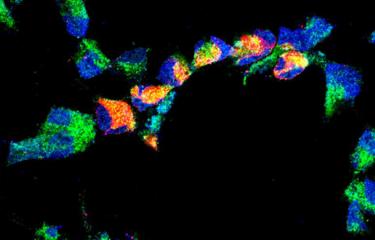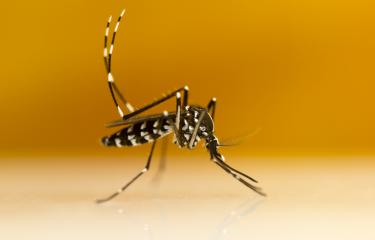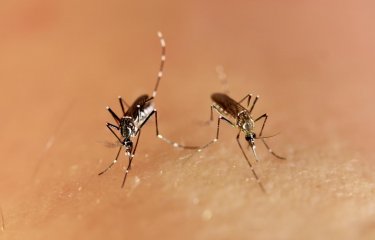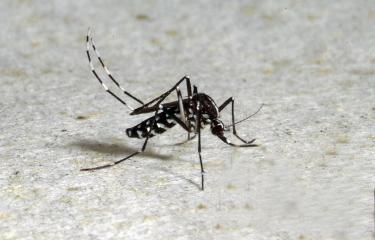The Institut Pasteur's Arboviruses and Insect Vectors Unit, led by Anna-Bella Failloux, working in cooperation with the Institut Pasteur International Network (the Institut Pasteur in Guadeloupe, the Institut Pasteur in French Guiana, the Instituto Oswaldo Cruz-Fiocruz and the Institut Pasteur in New Caledonia) and the Centre for Mosquito Control in Martinique, has carried out a study on the vector competence of seven populations of Aedes aegypti and Aedes albopictus collected in Guadeloupe, French Guiana, Martinique, Brazil and the United States.

On the left: Aedes aegypti mousquito, on the right: Aedes albopictus mousquito. © Institut Pasteur
These mosquitoes were infected with a strain of the Zika virus belonging to the Asian genotype, similar to the strain that is currently circulating in the Americas. The scientists followed the progress of the virus in the mosquito to analyze the mosquito's ability to become infected after taking a blood meal containing the virus, allow replication of the virus in its body cavity after it crosses the midgut epithelium, and transmit the virus via the salivary glands and saliva during a bite – a pivotal step in transmission.
The results, published in PLoS Neglected Tropical Diseases, show that, while Aedes aegypti and Aedes albopictus are both capable of becoming infected and replicating the virus in their body (the first two steps), they are not very competent when it comes to transmitting the Zika virus through a bite.
The scientists confirmed that transmission of the virus was only observed 14 days after the mosquitoes took an infected blood meal. This period – the time the virus takes to cover the entire "journey" through the mosquito to the salivary glands – is relatively long compared to that observed in the chikungunya virus, where it takes roughly 2 to 3 days. This information will be useful in efforts to implement vector control measures, which are currently the only effective method of containing the Zika epidemic.
The scientists therefore believe that the rapid spread of the Zika virus in the Americas should be attributed not to the vector competence of American mosquitoes, but rather to the vast human population that is immunologically naive to the new virus and lives near a high density of mosquito vectors.
Some information about the Zika virus and its mosquito vector
The Zika virus was first isolated in 1947 in a monkey in the Zika Forest in Kampala, Uganda. Its isolation once again the following year in Aedes africanus, a forest canopy mosquito that rarely feeds on humans, confirmed that this virus of African origin was an arbovirus (an arthropod-borne virus). The Zika virus belongs to the same family as the dengue and yellow fever (Flaviviridae) viruses, with which it shares the same vectors – mainly mosquitoes from the Aedes genus (which mostly bite during the day).
The Zika virus is traditionally maintained in a sylvatic cycle, which involves zoophilic mosquitoes and non-human primates. An epidemic cycle is mainly associated with transmission of the virus by an anthropophilic mosquito which generally takes its blood meals from humans. One such mosquito is Aedes aegypti, the vector involved in the Zika outbreaks in French Polynesia in 2013-2014, in New Caledonia in 2014 and in other Pacific islands. In May 2015, the Zika virus was detected in north-western Brazil, the starting point for an epidemic that has so far led to over 1.5 million cases. It has been reported in more than 26 Latin American and Caribbean countries.

To learn more, read the Zika fact sheet
Source
Differential susceptibilities of Aedes aegypti and Aedes albopictus from the Americas to Zika virus, Plos Neglected Tropical Diseases, March 3, 2016
Thais Chouin-Carneiro1¶, Anubis Vega-Rua2¶,#a, Marie Vazeille2, André Yebakima3, Romain Girod4, Daniella Goindin5, Myrielle Dupont-Rouzeyrol6, Ricardo Lourenço-de-Oliveira1, Anna-Bella Failloux2*
1 Instituto Oswaldo Cruz, Rio de Janeiro, Brazil
2 Institut Pasteur, Arboviruses and Insect Vectors, Paris, France
3 Centre for Mosquito Control in Martinique, Fort-de-France, Martinique
4 Institut Pasteur of French Guiana, Unit of Medical Entomology, Cayenne, French Guiana
5 Institut Pasteur of Guadeloupe, Laboratory of Medical Entomology, Environment and Health, Guadeloupe
6 Institut Pasteur of New Caledonia, Dengue and Arboviruses Research and Expertise Unit, Nouméa, New Caledonia
#a Current address: Institut Pasteur of Guadeloupe, Laboratory of Medical Entomology, Environment and Health, Guadeloupe
* Corresponding author
¶ These authors contributed equally to this work.









